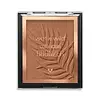What's inside
What's inside
 Key Ingredients
Key Ingredients

 Benefits
Benefits

 Concerns
Concerns

 Ingredients Side-by-side
Ingredients Side-by-side

Phenyl Trimethicone
Skin ConditioningSilica
AbrasiveAluminum Starch Octenylsuccinate
AbsorbentPolymethyl Methacrylate
Polyethylene
AbrasiveMicrocrystalline Wax
Emulsion StabilisingPhenoxyethanol
PreservativeDiethylhexyl Syringylidenemalonate
Skin ProtectingTocopheryl Acetate
AntioxidantCaprylyl Glycol
EmollientArgania Spinosa Kernel Oil
EmollientCaprylic/Capric Triglyceride
MaskingGlycerin
HumectantCI 77491
Cosmetic ColorantCI 77492
Cosmetic ColorantCI 77499
Cosmetic ColorantCI 77891
Cosmetic ColorantCI 42090
Cosmetic ColorantCI 17200
Cosmetic ColorantPhenyl Trimethicone, Silica, Aluminum Starch Octenylsuccinate, Polymethyl Methacrylate, Polyethylene, Microcrystalline Wax, Phenoxyethanol, Diethylhexyl Syringylidenemalonate, Tocopheryl Acetate, Caprylyl Glycol, Argania Spinosa Kernel Oil, Caprylic/Capric Triglyceride, Glycerin, CI 77491, CI 77492, CI 77499, CI 77891, CI 42090, CI 17200
Caprylic/Capric Triglyceride
MaskingSynthetic Fluorphlogopite
Boron Nitride
AbsorbentMicrocrystalline Cellulose
AbsorbentSilica
AbrasiveDimethicone
EmollientMagnesium Myristate
Dimethicone/Vinyl Dimethicone Crosspolymer
Skin ConditioningPhenoxyethanol
PreservativeLauroyl Lysine
Skin ConditioningCaprylyl Glycol
EmollientEthylhexylglycerin
Skin ConditioningHexylene Glycol
EmulsifyingTin Oxide
AbrasiveWater
Skin ConditioningO-Cymen-5-Ol
AntimicrobialTriethoxycaprylylsilane
Iron Oxides
CI 77492
Cosmetic ColorantCI 77499
Cosmetic ColorantMica
Cosmetic ColorantTitanium Dioxide
Cosmetic ColorantCaprylic/Capric Triglyceride, Synthetic Fluorphlogopite, Boron Nitride, Microcrystalline Cellulose, Silica, Dimethicone, Magnesium Myristate, Dimethicone/Vinyl Dimethicone Crosspolymer, Phenoxyethanol, Lauroyl Lysine, Caprylyl Glycol, Ethylhexylglycerin, Hexylene Glycol, Tin Oxide, Water, O-Cymen-5-Ol, Triethoxycaprylylsilane, Iron Oxides, CI 77492, CI 77499, Mica, Titanium Dioxide
 Reviews
Reviews

Ingredients Explained
These ingredients are found in both products.
Ingredients higher up in an ingredient list are typically present in a larger amount.
This ingredient is an emollient, solvent, and texture enhancer. It is considered a skin-softener by helping the skin prevent moisture loss.
It helps thicken a product's formula and makes it easier to spread by dissolving clumping compounds.
Caprylic Triglyceride is made by combining glycerin with coconut oil, forming a clear liquid.
While there is an assumption Caprylic Triglyceride can clog pores due to it being derived from coconut oil, there is no research supporting this.
Learn more about Caprylic/Capric TriglycerideCaprylyl Glycol is a humectant and emollient, meaning it attracts and preserves moisture.
It is a common ingredient in many products, especially those designed to hydrate skin. The primary benefits are retaining moisture, skin softening, and promoting a healthy skin barrier.
Though Caprylyl Glycol is an alcohol derived from fatty acids, it is not the kind that can dry out skin.
This ingredient is also used as a preservative to extend the life of products. It has slight antimicrobial properties.
Learn more about Caprylyl GlycolCi 77492 is also hydrated iron III oxide. It's sole purpose is to give a yellow hue to products.
Iron III oxides are classified as inorganic chemicals for coloring.
Synthetically created Ci 77492 is considered safer than those naturally found. This is because the synthetically created version may contain less impurities. Iron oxides are generally non-toxic and non-allergenic.
Learn more about CI 77492Ci 77499 is also hydrated iron III oxide. It is created from mixing red and black iron oxides. This helps give shades of darkness to a product.
Iron III oxides are classified as inorganic chemicals for coloring.
Phenoxyethanol is a preservative that has germicide, antimicrobial, and aromatic properties. Studies show that phenoxyethanol can prevent microbial growth. By itself, it has a scent that is similar to that of a rose.
It's often used in formulations along with Caprylyl Glycol to preserve the shelf life of products.
Silica, also known as silicon dioxide, is a naturally occurring mineral. It is used as a fine, spherical, and porous powder in cosmetics.
Though it has exfoliant properties, the function of silica varies depending on the product.
The unique structure of silica enhances the spreadability and adds smoothness, making it a great texture enhancer.
It is also used as an active carrier, emulsifier, and mattifier due to its ability to absorb excess oil.
In some products, tiny microneedles called spicules are made from silica or hydrolyzed sponge. When you rub them in, they lightly polish away dead skin layers and enhance the penetration of active ingredients.
Learn more about Silica